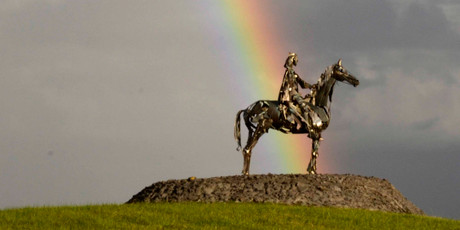Six Can’t-Miss Historical Sites in County Roscommon
Posted by Julia Brodsky on 25th Jun 2019
Located in the province of Connacht, Roscommon takes its name from the Irish ros, meaning a “wooded hill,” and Comán, the name of the abbot who founded the first Christian monastery there in 550. It is the birthplace of many notable Irishmen, including first President of Ireland, Douglas Hyde, and actor Chris O’Dowd, and home to numerous prehistoric forts, medieval castles, and grand estates.
Despite being landlocked, County Roscommon is bordered by water—Lough Key on the north, River Suck on the west, and the River Shannon and Lough Ree on the east. The area is largely rural, and a good place to go if you’re looking for a little space, as it is the 11th largest county in Ireland, but it ranks 27th in population. Maybe there’s something to be said for peace and quiet—a 2008 study reported that Roscommon has the longest life expectancy in all of Ireland!
6. RATHCROGHAN
Ireland’s ancient gems aren’t only in County Meath! Rathcroghan is thought to be the largest and oldest un-excavated royal site in Europe, with 240 identified archeological sites dating from the Neolithic to the Medieval period in an area of under three square miles. Queen Medbh, the ruler of Connacht and instigator of the legendary Táin Bó Cúailgne made her home at Rathcroghan (the visitor’s center offers a 15-minute video explaining the legendary and fantastical cattle raid). Visitors can also see Ireland’s Oweynagat Cave (Cave of Cats), which was once believed to be the entrance to the underworld.
5. RINN-DÚIN MEDIEVAL VILLAGE
Built by Henry III of England in 1227, Rinn-Dúin village once housed nearly 1,000 people before it was abandoned roughly 150 years later. Nearly 700 years later, a local parish facilitated the conservation of the site, which includes its town walls, a gatehouse, a windmill, a parish church, and even a hospital. Today, it is the best preserved Norman village in Ireland. Two short hiking trails offer views of the ruins and of Lough Ree.
4. ARIGNA MINING EXPERIENCE
Ever wondered it might be like to work as a coal miner? At the Arigna Mining Experience, visitors can learn just how the coal industry shaped the region and get a closer look at the grueling and dangerous routines of those who worked in the mines. Arigna is both Ireland’s first and last coal mine, having operated from the 17th century through 1990. The volume of work available at the mine even brought the area through the Famine years relatively unscathed compared to neighboring towns. Ex-miners lead visitors through the comprehensive tour, which brings guests over 1,000 feet underground, down to the coal face, and even includes a simulated explosion to illustrate the very real risks that miners confronted on a regular basis.
3. LOUGH KEY FOREST PARK
Lough Key is home to 32 small islands (coincidentally, the same number of counties in Ireland), many of which are dotted with picturesque ruins, like Trinity Island, where visitors can see a 12th century abbey, and Castle Island, named for its 19th century—you guessed it—castle. The park was once part of the Rockingham estate, and though the big house has burned down, several of its outbuildings remain.
If you’ve had your fill of ruined castles and mansions, Lough Key also boasts a panoramic treetop canopy walk, adventure park, and campgrounds.
2. BOYLE ABBEY
Boyle Abbey was the first successful Cistercian foundation in Connacht, established in 1161. Construction on the abbey took nearly 60 years to complete, however, as the buildings were not finished until 1220, and many different architectural details nod to changing European styles. Elizabethan armies took over Boyle Abbey in 1592, transforming it into their barracks, and in 1645, it was besieged by Cromwellian attackers. It is possible that in its derelict state, the structures were victim to stone quarrying, and today, little of the original cloister remains. Despite the abbey’s partial destruction, its ruins are still a sight to behold, and it is now a national monument.
1. STROKESTOWN PARK HOUSE & NATIONAL FAMINE MUSEUM
Though there are many grand Big Houses in County Roscommon, few are as rich in history as Strokestown Park. The imposing Palladian mansion was built in the early 18th century for the Packenham-Mahon family on the site of a ruined castle, the ancestral home of the displaced O’Connor-Roe chieftains. The estate’s biggest claim to fame is a bit macabre; in 1847 during the Famine, the estate’s landlord, Denis Mahon, was assassinated after evicting his tenants. Today, Strokestown Park offers guided tours in which visitors can view the six acres of walled gardens and home’s numerous rooms, stuffed with artifacts and ephemera including toys, children’s school materials, and kitchen ovens dating back to the 1740s. The grounds are also home to the National Famine Museum, which honors the legacy of the thousands who died or were forced to emigrate during Ireland’s Great Hunger.
******
Have you visited any of these historical sites in County Roscommon? Did we leave one of your favorite Roscommon spots off our list? Let us know in the comments below!

